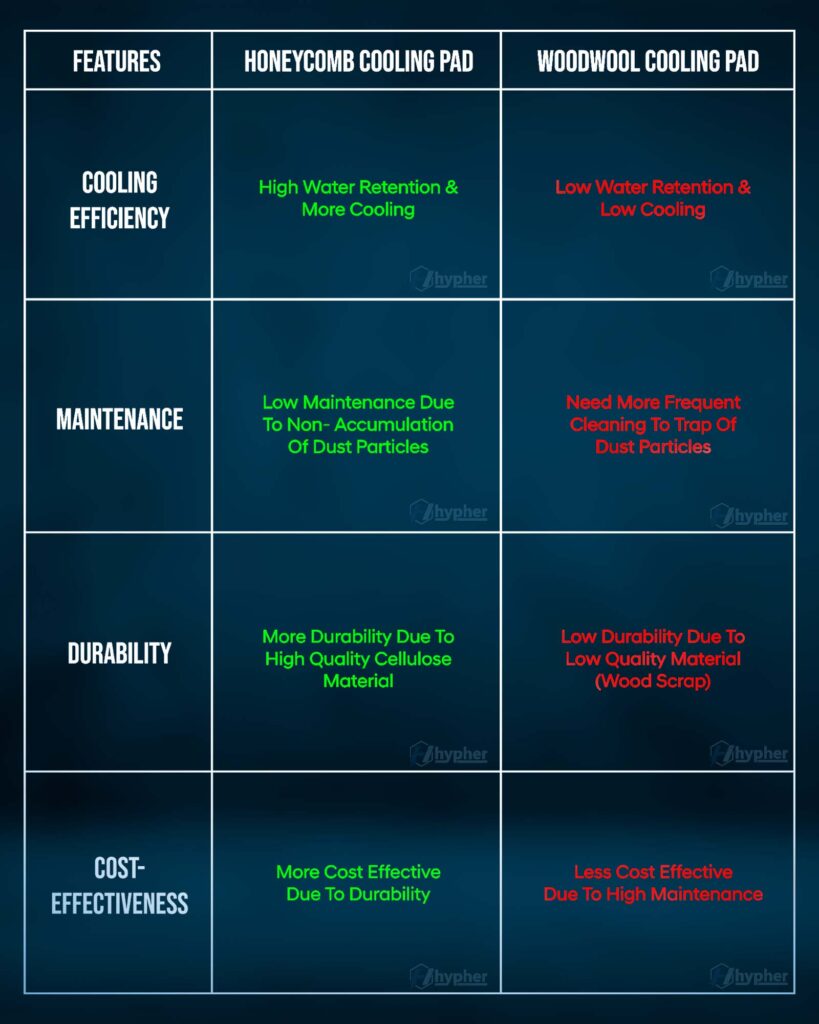As the scorching summer heat sets in, staying cool and comfortable becomes a top priority for many people. Traditional cooling methods often consume excessive energy and can be costly. However, with the advent of innovative cooling technologies, honeycomb cooling pads have emerged as an efficient and affordable solution to beat the heat. In this article, we will delver into the world of honeycomb cooling pads, exploring their benefits, Quality Parameters And usage.
Table of Contents
Efficient Cooling at an Affordable Price
Honeycomb cooling pads are highly regarded for their effectiveness in cooling indoor spaces while being energy-efficient. These pads are typically made of a cellulose material shaped in a honeycomb structure, which allows for maximum water retention and evaporation. When water is circulated through the pads, it evaporates, causing a drop in the air temperature.
Comparison between Traditional Wood Wool Pads and Honeycomb Cooling Pads

While both traditional wood wool pads and honeycomb cooling pads serve the purpose of cooling indoor spaces, they differ significantly in terms of performance and efficiency.
- Cooling Efficiency: Honeycomb cooling pads are widely regarded as more since honeycomb structure of the pads allows for increased surface area, enabling better water retention and evaporation. This leads to a more effective cooling process, resulting in lower ambient temperatures.
On the other hand, wood wool pads may have limitations in terms of water retention and evaporation, which can affect their overall cooling performance.
- Maintenance: Honeycomb cooling pads often require less maintenance compared to wood wool pads. The design of honeycomb pads allows for easy cleaning and prevents the accumulation of dirt and debris, ensuring optimal airflow. Wood wool pads, on the other hand, may need more frequent cleaning and replacement due to their tendency to trap dust and other particles.
- Durability: Honeycomb cooling pads are known for their durability, as they are typically made of high-quality cellulose materials. The honeycomb structure provides strength and longevity, allowing the pads to withstand continuous use and frequent water circulation. In contrast, wood wool pads may be prone to wear and tear over time, requiring more frequent replacement.
- Cost-effectiveness: Honeycomb cooling pads tend to be more cost-effective in the long run. Their efficient cooling performance leads to lower energy consumption, resulting in reduced utility bills. Additionally, their durability and longer lifespan contribute to cost savings by minimizing the need for frequent replacements. Wood wool pads, while initially cheaper, may incur higher maintenance and replacement costs over time.
In summary, honeycomb cooling pads outshine traditional wood wool pads in terms of cooling efficiency, durability, maintenance requirements, cost-effectiveness, and environmental impact. Choosing honeycomb cooling pads can provide a more efficient and reliable cooling solution for your space, ensuring a comfortable environment while minimizing energy consumption and expenses.
Also Check: Air Cooler for Big Room | 5 Key Factors To Be Consider
Now let us discuss various factors to be considered while evalvating honeycomb of a aircooler
- Material Quality: This made from high-quality cellulose material. Ensure that the pads are durable, water-resistant, and have excellent water retention capabilities. High-quality materials contribute to better cooling performance and longer pad lifespan.
- Pad Thickness: The thickness of honeycomb cooling pads can vary. Thicker pads typically provide better cooling efficiency as they offer a larger surface area for water evaporation. Consider the thickness that suits your cooling requirements and the space in which the pads will be installed.
- Water Distribution System: Evaluate the water distribution system of the cooling pads. The pads should have evenly distributed water outlets or nozzles to ensure uniform wetting of the entire pad surface. This ensures consistent cooling performance across the entire pad area.
Also Check: Hypher Rapid Aircooler
Follow Us: Facebook



One thought on “Honeycomb Cooling Pads | Honeycomb v/s Woodwool Cooling Pads”